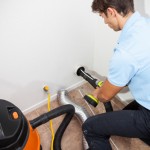 Houses built for mild climates often don’t need air conditioning units, despite some hot summer days that may benefit from them. For homes with forced air systems, furnaces often blast too much hot air, which is an inefficient heating method, especially in the spring and fall.
Houses built for mild climates often don’t need air conditioning units, despite some hot summer days that may benefit from them. For homes with forced air systems, furnaces often blast too much hot air, which is an inefficient heating method, especially in the spring and fall.
A solution worth considering in this scenario is a heat pump. This is a system that works a bit like an air conditioner or fridge but can run in reverse. It moves heat rather than generates it like traditional heating systems. In the cooler months, the heat pump brings warmth from outside and in the summer it moves the heat from inside the house to the outdoors.
Types of heat pumps include air-source, geothermal, dual-source and absorption.
Air source heat pumps
The popular ASHP uses both inside and outside air. The pump consists of a refrigeration system with a compressor and two coils of tubing. Refrigerant is compressed and circulated between the two coils, one inside and one outdoors. Think of it as an air conditioner that can work backwards.
In summer, the cooling cycle sends the refrigerant through an expansion device and to the coil inside the house that acts as an evaporator. The low-pressure liquid vaporizes absorbing heat. The hot vapor is then compressed, and once outside the house, heat is released from the outside coil. This acts as a condenser returning the hot gas to a cooler liquid. The cycle is reversed in the cooler months so that heat is released inside the house and the evaporator and condenser switch roles.
The drawback? Once temperatures approach freezing the efficiency is reduced. Think about it – there’s no heat to extract from the outside! In this situation the heat pump can use electric heaters or backup burners. Some manufacturers combine a furnace and heat-pump to create a hybrid system that shares ductwork and venting.
Geothermal heat pumps
Other kinds of heat pumps are more efficient in colder climates, such as geothermal ones. These use the consistent temperature of the ground several feet below the surface. Temperatures here are normally warmer than the air in the winter and cooler than the air in summer. Depending on the location, they typically range from 7°C to 21°C.
There are four geothermal types grouped into closed-loop and open-loop systems.
Closed loop systems can be horizontal, vertical or in a lake or pond. They are similar to the air-source type in that refrigerant is pumped through the ground where heat is absorbed in the winter months, or discharged in the summer months.
The open loop type uses a well or other surface water supply as the fluid in the system instead of refrigerant and circulates it back to its origin.
Dual source heat pumps
Another option is the dual source type – a combination of the air-source and geothermal methods. Geothermal heat pumps do not rely on outside air temperature and tend to be more reliable and quieter than air-source types. But, they’re pricey. A hybrid system brings the qualities of a geothermal system but at a lower cost.
Absorption heat pumps
Finally, absorption heat pumps are like the air-source type but instead of electricity they use a heat source. This can be from natural gas, propane, or from heated water either from solar power or geothermal. Instead of refrigerant they use ammonia or lithium bromide, which is absorbed into water. The solution is then pumped up to a higher pressure. The ammonia or lithium bromide is removed by heat and the cycle started again.



